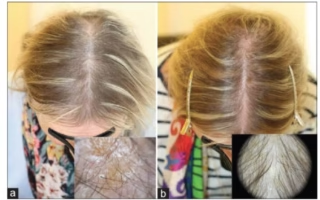Hair restoration is evolving rapidly, with two advanced therapies leading the way: Exosome therapy and PRP (Platelet-Rich Plasma) therapy. While both treatments aim to stimulate hair growth naturally, they work in different ways. If you’re considering treatment for thinning hair or early-stage hair loss, understanding the key differences between Exosomes and PRP is essential.
In this guide, we’ll break down how each treatment works, their benefits, safety, and results timeline, so you can make an informed decision.
- Read the full overview: Exosome Therapy for Hair Loss: Benefits, Risks & Results
- Curious about skin results? Check: Exosome Therapy for Skin Rejuvenation: Does It Really Work?
🌱 What is PRP for Hair Growth?
PRP therapy uses your own blood to stimulate hair growth. A small amount of blood is drawn, spun in a centrifuge, and the platelet-rich plasma is injected into the scalp. Platelets release growth factors that help improve follicle health and stimulate regrowth.
- Pros: 100% natural (from your own blood), widely available, relatively affordable.
- Cons: Multiple sessions needed, results may vary depending on age and hair loss stage.

🧬 What is Exosome Therapy for Hair Growth?
Exosome therapy uses extracellular vesicles derived from stem cells. These tiny messengers contain proteins, growth factors, and RNA that signal dormant hair follicles to wake up.
- Pros: More potent than PRP, requires fewer sessions, early studies show strong regrowth results.
- Cons: Expensive, relatively new with fewer long-term studies, availability limited to specialized clinics.
⚖️ Exosomes vs PRP: Side-by-Side Comparison
| Feature | PRP Therapy | Exosome Therapy |
| Source | Your own blood | Stem cell-derived vesicles |
| Potency | Moderate | High |
| Sessions Required | 4–6+ sessions | 1–3 sessions |
| Cost | Lower ($500–$1500/session) | Higher ($3000–$6000/session) |
| Onset of Results | 3–6 months | 2–3 months |
| Longevity of Results | 12–18 months | 18–24 months (est.) |
| FDA Approval | Widely used, well-studied | Emerging, still under clinical research |
💡 Which is Better for Hair Growth?
- Choose PRP if you’re looking for a natural, cost-effective option and don’t mind multiple sessions.
- Choose Exosomes if you want a more advanced, faster-acting treatment and are comfortable with higher costs and ongoing clinical validation.
Many clinics now combine PRP with Exosomes for enhanced results, giving patients the best of both worlds.
🌍 Expert Insights & Studies
- According to the American Academy of Dermatology (AAD), PRP has been widely used with proven safety, especially for androgenetic alopecia.
- Early clinical trials on Exosome therapy (source: National Library of Medicine) show promising regrowth and improved scalp health, but more long-term studies are needed.
❓ FAQs: Exosomes vs PRP for Hair Growth
PRP is considered extremely safe since it uses your own blood. Exosomes are also safe but require strict sourcing and medical expertise.
Exosomes usually show visible results within 2 – 3 months, while PRP may take 3 – 6 months.
Yes! Some clinics combine both therapies to maximize follicle stimulation.
Neither therapy is permanent maintenance sessions may be needed depending on your hair loss condition.
📝 Final Thoughts
Both PRP and Exosomes are game-changers in the world of hair restoration. While PRP is a proven, budget-friendly option, Exosomes represent the future of regenerative hair medicine with stronger potential.
👉 Start with a dermatologist consultation to assess your stage of hair loss and determine which treatment fits your goals.
✍️ GlowNest Care Team
This article was researched and written by the GlowNest Care Team, a group dedicated to bringing you the latest insights in skincare, haircare, and wellness science. Our mission is to simplify complex topics like exosome therapy and PRP hair growth treatments, helping you make confident and informed choices for your health and beauty.
📖 Read More: Explore our latest skincare tips, haircare routines, mani-pedi care guides, overall beauty care advice, weekly glow tips, FAQs on trending topics, and handy beauty calculators to keep your glow strong.
🔗 Share This Post: Found it helpful? Share it with friends, family, or on social media to spread the knowledge and inspire healthier skin.
💬 Join the Discussion: Scroll down and leave your thoughts or questions in the comments – we’d love to hear from you!



